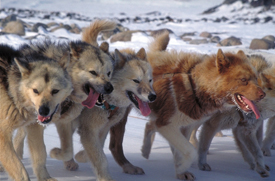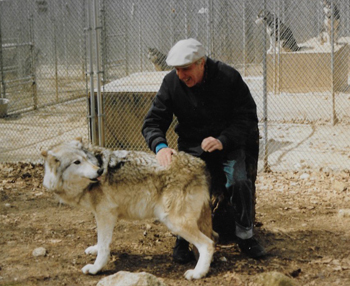Defining
the Inuit Dog
Canis familiaris borealis
by Sue Hamilton
Canis familiaris borealis
by Sue Hamilton
© December 2011,
The Fan Hitch, all rights reserved
revised: December 2020
revised: December 2020
I. Introduction
A. The Inuit
Dog’s place in the natural world
B. The Inuit Dog is not a wolf!
C. Dangerous confusion
B. The Inuit Dog is not a wolf!
C. Dangerous confusion
A.
The Name Controversy
B. Defining 'Purity'
C. Mistaken Identity: Promoting a breed vs. avoiding
extinction
D. The Belyaev Experiment
E. Summary
B. Defining 'Purity'
C. Mistaken Identity: Promoting a breed vs. avoiding
extinction
D. The Belyaev Experiment
E. Summary
A.
Ancient history
B. Recent history: The Inuit Dog in service to nations
B. Recent history: The Inuit Dog in service to nations
1.
Exploration
2. War
3. Sovereignty
2. War
3. Sovereignty
C. Population
decline
A.
In the North
B. Below the tree line
B. Below the tree line
A. Inherited
diseases
B. Disease prevention and access to veterinary services
B. Disease prevention and access to veterinary services
A. Appearance
B. Behavior
C. Performance
D. The big picture
VII.
The Inuit Dog in Scientific Research, Films
andB. Behavior
C. Performance
D. The big picture
in Print
VIII. Acknowledgements
Appendix 1: Partial list of scientific publications about
the Inuit Dog
Appendix 2: Selected (alphabetical) list of other resources
with a focus on Inuit Dogs
Appendix 3: A small sampling of other resources of
interest
Navigating This Site
Index of articles by subject
Index of back issues by volume number
Search The Fan Hitch
Articles to download and print
Defining the Inuit Dog
Ordering Ken MacRury's Thesis
Our comprehensive list of resources
About The Fan Hitch
Talk to The Fan Hitch
The Fan Hitch home page
Editor-in-Chief: Sue Hamilton
Webmaster: Mark Hamilton
The Fan Hitch,
Journal of the Inuit Sled Dog, is published
four times a year. It is available at no
cost online at: https://thefanhitch.org.
The Fan Hitch welcomes your letters, stories, comments and suggestions. The editorial staff reserves the right to edit submissions used for publication.
Contents of The Fan Hitch are protected by international copyright laws. No photo, drawing or text may be reproduced in any form without written consent. Webmasters please note: written consent is necessary before linking this site to yours! Please forward requests to Sue Hamilton, 55 Town Line Rd., Harwinton, Connecticut 06791, USA or mail@thefanhitch.org
This site is dedicated to the Inuit Dog as well as related Inuit culture and traditions. It is also home to The Fan Hitch, Journal of the Inuit Sled Dog.
The Fan Hitch welcomes your letters, stories, comments and suggestions. The editorial staff reserves the right to edit submissions used for publication.
Contents of The Fan Hitch are protected by international copyright laws. No photo, drawing or text may be reproduced in any form without written consent. Webmasters please note: written consent is necessary before linking this site to yours! Please forward requests to Sue Hamilton, 55 Town Line Rd., Harwinton, Connecticut 06791, USA or mail@thefanhitch.org
This site is dedicated to the Inuit Dog as well as related Inuit culture and traditions. It is also home to The Fan Hitch, Journal of the Inuit Sled Dog.

They just keep pulling! Spring in North Greenland
Photograph courtesy of Greenland Tourism.
VIII: Acknowledgements
I wish to express my gratitude to all those whose patience and expertise aided me in the preparation of this document. Some of the material included in "Defining the Inuit Dog" is from personal conversations with and the writings (including important contributions to The Fan Hitch publications) of:
Vladimir Beregovoy, PhD.
Vladimir Beregovoy graduated
in 1960 as a biologist from Perm State University in Perm,
Perm Krai, Russia. He defended his dissertation in 1964
and was awarded a Degree of Candidate of Sciences from the
Institute of Biology, Uralian Branch of Academy of
Sciences of the USSR, where he worked as a zoologist. He
taught at the Kuban State University, Krasnodar. During
his work as a zoologist, he traveled to Ural, West
Siberia, Volga River region, Kazakhstan and North
Caucasus. Beregovoy has published several articles in
popular magazines and two books: Primitive Breeds-Perfect
Dogs and Hunting Laika Breeds of
Russia. He is also the advisor and curator
of the Primitive and Aboriginal Dog Society, International
(PADS) as well as a member of the editorial board of the
PADS Journal.
Johan and Edith Gallant
During travels through
southern Africa in their quest for the essence of the dog,
the Gallants discovered native African dogs. They realized
that all those years as ill-informed bystanders,
exhibiting at shows, participating in obedience and
working trials and eventually judging, they had looked at
these native dogs with contempt. The western worship of
"pure" breeds of dogs had veiled their vision of native
African dogs. They soon were faced with the fact that
these rural dogs represented an ancient landrace,
certainly not 'improved' or streamlined into fashionable
homogeneity. But their behavior is so intense and uniform,
their physical prowess and health condition so remarkable
that they inspired the Gallants to begin in-depth
research. They named this African dog AfriCanis. Johan was
co-founder and chairman of the AfriCanis Society. The
Gallants perspective and respect for canine landraces
emerged from their apprehension that Canis familiaris, the
domestic dog as a whole had been badly misunderstood.
Their book, SOS Dog: The Purebred Dog
Hobby Re-examined was written to be the
dog's mouthpiece. Edith Gallant carries on with the work
with the AfriCanis.
Benson Ginsberg, PhD.
Benson Ginsburg, professor
emeritus of Psychology (University of Connecticut -
UCONN), was among the first to study behavior genetics, a
scientific discipline of which he was one of the founding
fathers and preeminent leaders. He also established and,
for sixteen years prior to his retirement, headed the
Biobehavioral Sciences Department at the UCONN Storrs
campus. His department reflected an approach to research
ranging from the biology of the brain and behavior to
anthropology, neurobiology, and psychology.
Dr. Ginsburg's research was devoted to relating behavior to genes and involved studies of the evolution of social behavior using animal models which included dogs and their wild relatives: wolves and coyotes. His early studies of canid socialization and wolf social and reproductive behavior were focused, in part, on the degree to which there was flexibility in social development and specifically whether there was a critical period during development after which wolf pups could not be socialized to humans.
Dr. Ginsburg was the author and co-author of scores books and scientific publications, many of them about canid genetics and behavior.
Dr. Ginsburg's research was devoted to relating behavior to genes and involved studies of the evolution of social behavior using animal models which included dogs and their wild relatives: wolves and coyotes. His early studies of canid socialization and wolf social and reproductive behavior were focused, in part, on the degree to which there was flexibility in social development and specifically whether there was a critical period during development after which wolf pups could not be socialized to humans.
Dr. Ginsburg was the author and co-author of scores books and scientific publications, many of them about canid genetics and behavior.
Ken MacRury
Ken MacRury moved to the
Canadian Arctic in 1971. During the two years he lived in
Igluliq (1974-1976), he was introduced to "real dog teams
and real drivers", traveling and hunting by Inuit Dog team
in a traditional manner under the mentoring of a respected
Inuk dog man. During that time, Ken introduced Bill
Carpenter to people who were able to provide foundation
dogs for Carpenter and McGrath’s Eskimo Dog Recovery
Project in Yellowknife, NWT. Ken collaborated with the
program by exchanging breeding stock. In 1991 he completed
his thesis, The Inuit Dog: Its
Provenance, Environment and History, in
fulfillment of his Master of Philosophy in Polar Studies
at Darwin College, Scott Polar Research Institute,
University of Cambridge, England. This document remains
today the most comprehensive scientific study of the
aboriginal dog of the circumpolar north and it is still
much sought after as a valuable resource for northern dog
enthusiasts, scientists, authors and filmmakers worldwide
as well as aboriginal and non-aboriginal government
agencies and Inuit cultural organizations. Ken has granted
exclusive publication and distribution rights to his
thesis to Mark and Sue Hamilton, owners of The Fan Hitch
Website and Publications of the Inuit Sled Dog. His
generosity has not only served to support The Fan Hitch's
web hosting services, but also has enabled The Fan
Hitch to donate copies of the thesis and
monetary contributions to entities who further the best
interest of Inuit Sled Dogs in the North.
From his time in Igluliq and through the balance of his northern stay in Iqaluit on Baffin Island until his retirement and relocation to Atlantic Canada in 2002, Ken kept, bred, traveled and hunted with Inuit Dogs.
From his time in Igluliq and through the balance of his northern stay in Iqaluit on Baffin Island until his retirement and relocation to Atlantic Canada in 2002, Ken kept, bred, traveled and hunted with Inuit Dogs.
Also I would like to thank all the wonderful folks who, since the birth of The Fan Hitch's publications, have unselfishly granted permission to use their photographs.
Thank you to my husband Mark for his collaboration, suggestions and saint-like patience in formatting and mounting text and images to the web and making all those seemingly endless links, re-writes, edits and corrections; and thanks again to Ken MacRury for his critical review of this entire document and helping to polish it; and to Lucille Murphy of MaineMade Dog Sleds for "combing over" every word, space, punctuation mark and sentence in order to identify all the glitches I missed!
Special thanks to Jayko and Philippa Ootoowak for their kindness, patience, generosity and mentoring; to Puggiq, Amaruq and Tiriganiaq, our first three Inuit Dogs, who literally led us down new life trails; and to Tewa and Miranda, two North American grey wolves from Dr. Ginsburg's behavior research program, who spent their retirement years in our kennel teaching us so much about the naturally wild side of canids.

Benson Ginsburg and Miranda in Hamilton’s kennel exercise pen.
Photo: Hamilton
Return to the top of the page